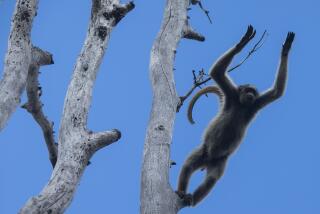Space monkeys: The humanizing of Able and Baker
- Share via
Before they were sedated and loaded into the nose cone of a stubby Jupiter missile, the monkeys Able and Baker were just the latest in a growing number of rocket-test animals who, more often than not, met a violent end.
But on May 25, 1959, after reaching the very edge of space about 60 miles above Earth’s surface, the primates splashed down in the Atlantic Ocean, and were recovered by U.S. Navy frogmen.
“Able/Baker perfect,” came the radio message. “No injuries or other difficulties.”
The fanfare that greeted their return was unlike anything seen before. The furry monkeynauts were pictured before an American flag on the cover of Life magazine, and their adventure was recounted in a Universal News newsreel.
While military and scientific handlers were discouraged from developing “emotional attachments” to primate test subjects -- the creatures were typically given designations such as “21X,” “3Y” or “299+” instead of names -- Abel and Baker were accorded special status.
In a paper presented this week at the International Congress of History of Science, Technology and Medicine, in Manchester, England, science and technology graduate student Jordan Bimm argued that NASA and the government anthropomorphized the creatures for publicity purposes, as well as to defuse potential public outcry against the use of monkeys as test subjects.
“There is a big contrast between Able and Baker and all the monkeys that were used before them,” wrote Bimm of York University in Toronto. “Those animals were regarded as instruments, traded in groups, and recalled only by a seemingly random alphanumeric code. After their flight, Able and Baker ... were taken up as individuals with human qualities.”
Bimm notes that while human women were excluded from the early space program, Able, a rhesus monkey, and Baker, a squirrel monkey, were both females.
As the first monkeys to reach space and be returned to Earth intact, the pair held special significance for the space program. Almost immediately, however, there was a problem.
A week after landing, Able died under anesthetic as doctors attempted to remove an EEG electrode that was implanted in her chest for study during spaceflight.
A team of doctors worked two hours trying to revive the rhesus -- blowing air into her lungs through a tube, injecting adrenalin, and cutting into her chest -- but were “visibly defeated” when their efforts failed, Bimm wrote.
Animal deaths were not uncommon in the early space program. A number of test primates had been killed during test flights using Nazi V-2 rockets seized at the end of World War II, and were given no special recognition.
In another instance, a series of experiments that used hogs to study high-speed crashes was dubbed “Project Barbeque,” as the test subjects were eaten after autopsy, Bimm wrote.
Able was different, however. She was taxidermied, placed into her flight “couch” and put on permanent display at the National Air and Space Museum at the Smithsonian.
“Once Able’s value as a scientific instrument unexpectedly ended, humans found new uses for her,” Bimm wrote. “Stuffed and on display, Able continues to serve as an unwilling representative of the U.S. space program, silently vouching for the inherent value and moral imperative in pursuing space science.”
Baker faced a very different fate.
Her biometric probes were successfully removed without anesthetic and she was soon given a new life as “Miss Baker: America’s First Lady of Space.”
She was twice “married” to male squirrel monkeys -- “Big George” and “Norman” -- and given residence in an air-conditioned, family “bungalow” at the U.S. Space and Rocket Center in Huntsville, Ala.
A special handler helped her respond to fan mail by inking her hand and stamping it on glossy self-portraits. She appeared in newspaper articles and on television programs with Dinah Shore and Mike Douglas.
Baker died in 1984 at the age of 27.
“She was even anthropomorphized in death, being interred beneath a large marble headstone,” Bimm wrote. “Today, children who visit the center are instructed to place an unpeeled banana on top of her grave in tribute.”
Return to Science Now blog.
Follow me on Twitter @montemorin







